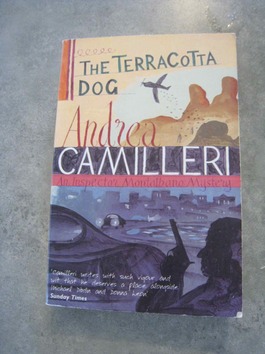Sunday, 10 October 2010

The second novel in the Montalbano series, The Terracotta Dog starts off with a secret face-to-face meeting with dreaded Mafioso Tano the Greek, a tired Mafia boss, disillusioned with the contemporary criminal style, who wants to have himself arrested while still managing to maintain face. The plan to have him captured at the end of a heroic gun battle, predictably, doesn’t work out as planned and Tano's enemies manage to take him out anyway.
That’s only one element in an assortment of strange circumstances.
Thieves quite blatantly clean out Carmelo Ingrassia's supermarket, but leave the stolen merchandise in a tractor trailer behind a nearby petrol station.
An eighty-year-old ex-Fascist who happened to be passing the supermarket at the time and prides himself on his slow driving dies in a single-vehicle high-speed crash shortly after telling Montalbano he has information for him.
There's no obvious connection between those elements, but as Montalbano goes about his business threads from each incident become intertwined with the others.
Strangest of all, the discovery of a hidden cache of weapons in a cave at an abandoned road construction site leads to Montalbano’s discovery of a concealed inner cave with symbolic artefacts, the mummified bodies of two young lovers and the terracotta dog of the title, carefully arranged in what appears to be some kind of ancient ritual.
Unsurprisingly, Montalbano can’t help but become obsessed with establishing the identities of the couple and figuring out how they came to be there. A case of who-was-it rather than who-done-it, though he wants to figure that out as well.
In the end it takes a combination of deduction, legwork, insider knowledge, animal cunning and a dash of luck to put the pieces together.
As one of the earlier titles in a lengthy series, there are elements in the story that aren’t quite as neatly tied together as the plot line.
Catarella makes his appearance, foisted on Montalbano by nepotistic connections while apparently blissfully ignorant of how he got there, and there’s also the matter of rivalry between Montalbano and his second-in-command, Mimi Augello that needs to be sorted out as the series continues.
Both Livia and Ingrid turn up along the way and while a bullet in the colon and Catarella’s status as an emergency blood donor raises the prospect of the dark years that lay ahead of him, surviving on Catarella’s blood and eating semolina mush you know things are going to work out (more or less) in the end.